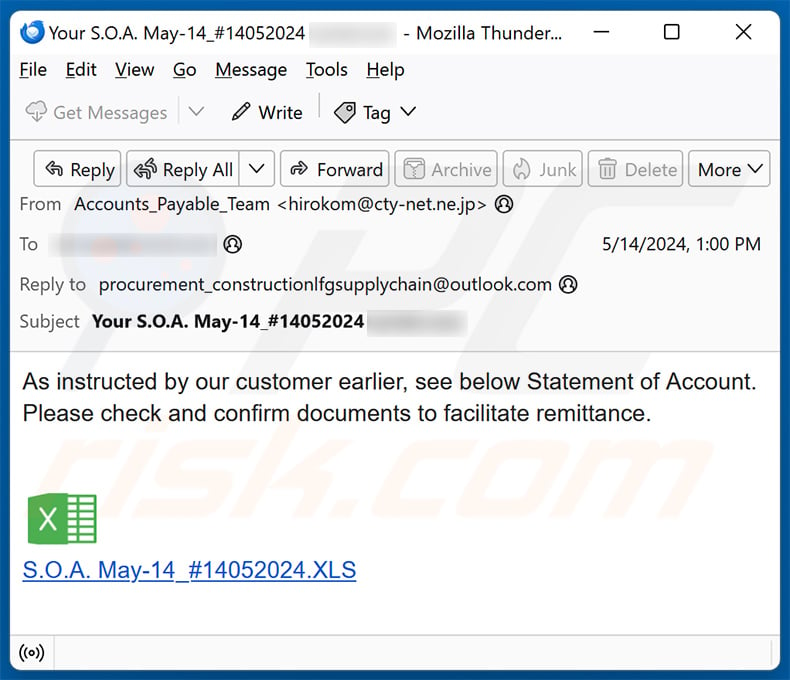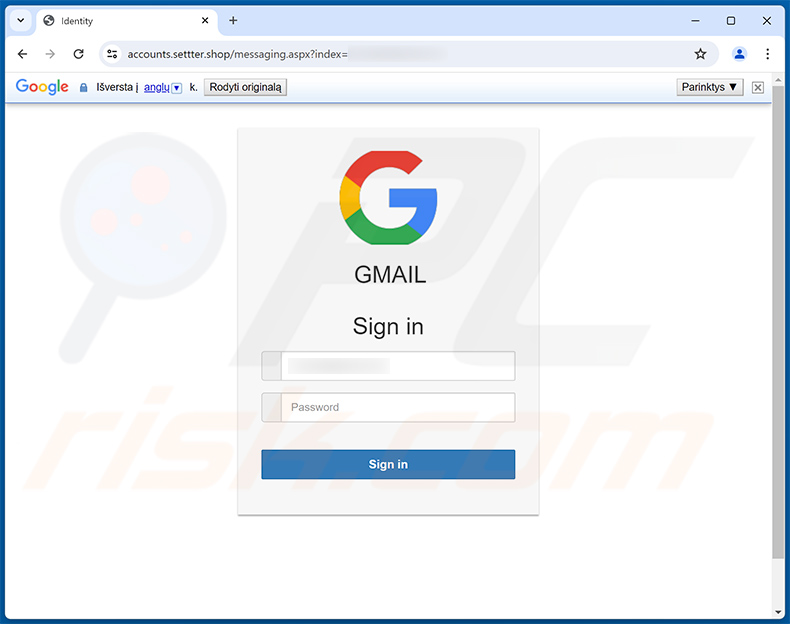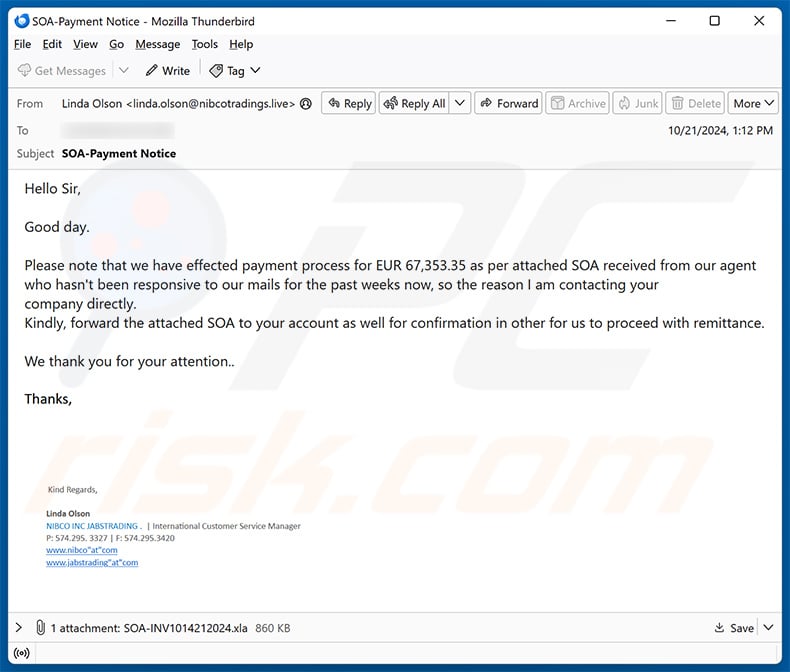How to spot fake emails like "Statement Of Account (SOA)" malspam email
Phishing/ScamAlso Known As: Statement Of Account (SOA) malspam
Get free scan and check if your device is infected.
Remove it nowTo use full-featured product, you have to purchase a license for Combo Cleaner. Seven days free trial available. Combo Cleaner is owned and operated by RCS LT, the parent company of PCRisk.com.
What is "Statement Of Account (SOA) email virus"?
After examining this email, we concluded that this is a fake email regarding a statement of account. It has a malicious PDF document attached to it. Cybercriminals behind this email aim to lure recipients into downloading and executing malware called Rhadamanthys.

"Statement Of Account (SOA) malspam email overview
This email encourages recipients to review the attached file (a statement of account containing purchase orders and corresponding invoices) and confirm all details to arrange a payment. The attached file is a PDF document named "Statement.pdf". As we mentioned in the introduction, that document is malicious.
That PDF document contains a fake message claiming that an update for Adobe Acrobat is available. The message contains "Download Update" and "Download Document" hyperlinks. Clicking those links downloads a malicious executable file designed to inject Rhadamanthys malware.
Rhadamanthys is malware that can collect device data (e.g., OS version, installed software, IP addresses), execute certain PowerShell commands, exfiltrate document files, and extract passwords and passphrases from cryptocurrency wallets.
Having a computer infected with Rhadamanthys may lead to additional infections, identity theft, monetary loss, and other issues. Thus, the file attached to the Statement Of Account (SOA) malspam email must not be opened.
| Name | Statement Of Account (SOA) malspam |
| Threat Type | Trojan, password-stealing virus, banking malware, spyware. |
| Hoax | The email contains a statemenf of account |
| Attachment(s) | Statement.pdf |
| Detection Names (Attached PDF Document) | Avast (PDF:DropperX-gen [Drp]), Combo Cleaner (Trojan.GenericKD.64875678), ESET-NOD32 (PDF/TrojanDownloader.Agent.AOT), Kaspersky (HEUR:Trojan-Downloader.PDF.Agent.gen), Microsoft (Trojan:Win32/Leonem), Full List Of Detections (VirusTotal) |
| Symptoms | Trojans are designed to stealthily infiltrate the victim's computer and remain silent, and thus no particular symptoms are clearly visible on an infected machine. |
| Payload | Rhadamanthys malware |
| Distribution methods | Infected email attachments, malicious online advertisements, social engineering, software 'cracks'. |
| Damage | Stolen passwords and banking information, identity theft, the victim's computer added to a botnet. |
| Malware Removal (Windows) |
To eliminate possible malware infections, scan your computer with legitimate antivirus software. Our security researchers recommend using Combo Cleaner. Download Combo CleanerTo use full-featured product, you have to purchase a license for Combo Cleaner. 7 days free trial available. Combo Cleaner is owned and operated by RCS LT, the parent company of PCRisk.com. |
Malspam in general
Emails containing malicious attachments or links usually are disguised as important/official/urgent letters from legitimate companies (or other entities) or real people. The purpose of these emails is to trick users into downloading and executing malware (or opening pages designed to perform unauthorized drive-by downloads).
More examples of emails used to deliver malware are "Pending Payment Email Virus", "Annual Leave Email Virus", and "Concept Design Drawings Email Virus".
How did "Statement Of Account (SOA) email virus" infect my computer?
Cybercriminals behind the Statement Of Account (SOA) malspam email succeed when recipients open the attached file, click one of the provided hyperlinks and execute the downloaded executable file.
More examples of files used to trick users into executing malware are malicious MS Office documents, JavaScript files, archives containing malicious files, and ISO files. Users infect computers after downloading and executing malware (e.g., enabling macros commands in malicious MS Office documents).
How to avoid installation of malware?
Do not trust irrelevant emails sent from unknown addresses. Especially when suspicious emails contain links or attachments. Double-check emails before opening their contents. Download software from official pages (or verified stores) only. Do not trust advertisements on questionable pages.
Keep the operating system and installed programs updated. Never use third-party/unofficial tools to update or activate any software (including the operating system). Use reputed antivirus software.
If you've already opened "Statement Of Account (SOA) email virus" attachment, we recommend running a scan with Combo Cleaner Antivirus for Windows to automatically eliminate infiltrated malware.
Text presented in the "Statement Of Account (SOA)" email letter:
Subject: Fw: Statement(SOA)
Good morning,
Please find attached your statement of account (SOA) showing
purchase orders and corresponding invoices.
Kindly download the attached document and confirm all details to
enable us arrange payment.
Endeavour to confirm the correctness of the invoice total and
your bank account details.Your immediate response will be highly appreciated.
The Hongkong and Shanghai Banking Corporation
HSBC
Malicious attachment distributed via "Statement Of Account (SOA)" malspam campaign:

Screenshot of a Statement Of Account (SOA)-themed spam email promoting a phishing site:

Text presented within:
Subject: Your S.O.A. May-14_#14052024 ********
As instructed by our customer earlier, see below Statement of Account. Please check and confirm documents to facilitate remittance.
Untitled.png
S.O.A. May-14_#14052024.XLS
Screenshot of the promoted phishing site:

Another example of an email from "Statement Of Account (SOA)" spam campaign:

Text presented within:
Subject: SOA-Payment Notice
Hello Sir,
Good day.
Please note that we have effected payment process for EUR 67,353.35 as per attached SOA received from our agent who hasn't been responsive to our mails for the past weeks now, so the reason I am contacting your company directly.
Kindly, forward the attached SOA to your account as well for confirmation in other for us to proceed with remittance.We thank you for your attention..
Thanks,
Kind Regards,
Linda Olson
NIBCO INC JABSTRADING . | International Customer Service Manager
P: 574.295. 3327 | F: 574.295.3420
www.nibco"at"com
www.jabstrading"at"com
Instant automatic malware removal:
Manual threat removal might be a lengthy and complicated process that requires advanced IT skills. Combo Cleaner is a professional automatic malware removal tool that is recommended to get rid of malware. Download it by clicking the button below:
DOWNLOAD Combo CleanerBy downloading any software listed on this website you agree to our Privacy Policy and Terms of Use. To use full-featured product, you have to purchase a license for Combo Cleaner. 7 days free trial available. Combo Cleaner is owned and operated by RCS LT, the parent company of PCRisk.com.
Quick menu:
- What is Statement Of Account (SOA) malspam?
- Types of malicious emails.
- How to spot a malicious email?
- What to do if you fell for an email scam?
Types of malicious emails:
![]() Phishing Emails
Phishing Emails
Most commonly, cybercriminals use deceptive emails to trick Internet users into giving away their sensitive private information, for example, login information for various online services, email accounts, or online banking information.
Such attacks are called phishing. In a phishing attack, cybercriminals usually send an email message with some popular service logo (for example, Microsoft, DHL, Amazon, Netflix), create urgency (wrong shipping address, expired password, etc.), and place a link which they hope their potential victims will click on.
After clicking the link presented in such email message, victims are redirected to a fake website that looks identical or extremely similar to the original one. Victims are then asked to enter their password, credit card details, or some other information that gets stolen by cybercriminals.
![]() Emails with Malicious Attachments
Emails with Malicious Attachments
Another popular attack vector is email spam with malicious attachments that infect users' computers with malware. Malicious attachments usually carry trojans that are capable of stealing passwords, banking information, and other sensitive information.
In such attacks, cybercriminals' main goal is to trick their potential victims into opening an infected email attachment. To achieve this goal, email messages usually talk about recently received invoices, faxes, or voice messages.
If a potential victim falls for the lure and opens the attachment, their computers get infected, and cybercriminals can collect a lot of sensitive information.
While it's a more complicated method to steal personal information (spam filters and antivirus programs usually detect such attempts), if successful, cybercriminals can get a much wider array of data and can collect information for a long period of time.
![]() Sextortion Emails
Sextortion Emails
This is a type of phishing. In this case, users receive an email claiming that a cybercriminal could access the webcam of the potential victim and has a video recording of one's masturbation.
To get rid of the video, victims are asked to pay a ransom (usually using Bitcoin or another cryptocurrency). Nevertheless, all of these claims are false - users who receive such emails should ignore and delete them.
How to spot a malicious email?
While cyber criminals try to make their lure emails look trustworthy, here are some things that you should look for when trying to spot a phishing email:
- Check the sender's ("from") email address: Hover your mouse over the "from" address and check if it's legitimate. For example, if you received an email from Microsoft, be sure to check if the email address is @microsoft.com and not something suspicious like @m1crosoft.com, @microsfot.com, @account-security-noreply.com, etc.
- Check for generic greetings: If the greeting in the email is "Dear user", "Dear @youremail.com", "Dear valued customer", this should raise suspiciousness. Most commonly, companies call you by your name. Lack of this information could signal a phishing attempt.
- Check the links in the email: Hover your mouse over the link presented in the email, if the link that appears seems suspicious, don't click it. For example, if you received an email from Microsoft and the link in the email shows that it will go to firebasestorage.googleapis.com/v0... you shouldn't trust it. It's best not to click any links in the emails but to visit the company website that sent you the email in the first place.
- Don't blindly trust email attachments: Most commonly, legitimate companies will ask you to log in to their website and to view any documents there; if you received an email with an attachment, it's a good idea to scan it with an antivirus application. Infected email attachments are a common attack vector used by cybercriminals.
To minimise the risk of opening phishing and malicious emails we recommend using Combo Cleaner Antivirus for Windows.
Example of a spam email:

What to do if you fell for an email scam?
- If you clicked on a link in a phishing email and entered your password - be sure to change your password as soon as possible. Usually, cybercriminals collect stolen credentials and then sell them to other groups that use them for malicious purposes. If you change your password in a timely manner, there's a chance that criminals won't have enough time to do any damage.
- If you entered your credit card information - contact your bank as soon as possible and explain the situation. There's a good chance that you will need to cancel your compromised credit card and get a new one.
- If you see any signs of identity theft - you should immediately contact the Federal Trade Commission. This institution will collect information about your situation and create a personal recovery plan.
- If you opened a malicious attachment - your computer is probably infected, you should scan it with a reputable antivirus application. For this purpose, we recommend using Combo Cleaner Antivirus for Windows.
- Help other Internet users - report phishing emails to Anti-Phishing Working Group, FBI’s Internet Crime Complaint Center, National Fraud Information Center and U.S. Department of Justice.
Frequently Asked Questions (FAQ)
Why did I receive this email?
This email is not personal. Most often, threat actors behind malspam campaigns send the same letters to all recipients.
I have downloaded and opened a file attached to this email, is my computer infected?
Opening the file attached to this email ("Statement.pdf") is harmless. However, clicking the "Download Update" or "Download Document" hyperlink and opening the downloaded executable file infects a computer with Rhadamanthys.
I have read the email but didn't open the attachment, is my computer infected?
It is safe to open emails even when they contain malicious files or links. Computers cannot be infected by emails.
Will Combo Cleaner remove malware infections that were present in email attachment?
Yes, Combo Cleaner will run a system scan and remove detected malware. This application can detect almost all known malware. It is important to mention that high-end malware usually hides deep in the system. Thus, running a full system scan is a must to eliminate it.
Share:

Tomas Meskauskas
Expert security researcher, professional malware analyst
I am passionate about computer security and technology. I have an experience of over 10 years working in various companies related to computer technical issue solving and Internet security. I have been working as an author and editor for pcrisk.com since 2010. Follow me on Twitter and LinkedIn to stay informed about the latest online security threats.
PCrisk security portal is brought by a company RCS LT.
Joined forces of security researchers help educate computer users about the latest online security threats. More information about the company RCS LT.
Our malware removal guides are free. However, if you want to support us you can send us a donation.
DonatePCrisk security portal is brought by a company RCS LT.
Joined forces of security researchers help educate computer users about the latest online security threats. More information about the company RCS LT.
Our malware removal guides are free. However, if you want to support us you can send us a donation.
Donate
▼ Show Discussion